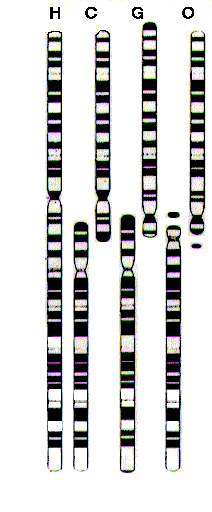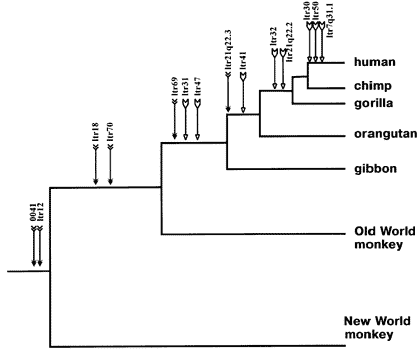as evidence species ever change or changed into different species ?
The mere fact that there are (diverse) species ?
The mere fact that there are (diverse) species ?
Yes, i'm interested in discussion on a discussion forum. i know it sounds strange. Like i asked you: if you have nothing to write here directly on point to my OP, but only want others to go read elsewhere, please don't post on my thread. Pretty please.Are you only interested in arguing, piglet? Because if you were truly interested in learning what evidence there is for speciation, you would have read the links I provided for you.
How 'bout just one, even one, teeny weeny little thing ?Do I have to copy and paste everything to this message board before you will consider it?
If you're just looking to fight rather than try to evidence, you might try anyone elses' thread but mine.If you're just looking to fight, you might try the Creation vs. Evolution board.
Formation of five new species of cichlid fishes which formed since they were isolated less than 4000 years ago from the parent stock, Lake Nagubago. (Test for speciation in this case is by morphology and lack of natural interbreeding. These fish have complex mating rituals and different coloration. While it might be possible that different species are inter-fertile, they cannot be convinced to mate.)
Mayr, E., 1970. Populations, Species, and Evolution, Massachusetts, Harvard University Press. p. 348
The reason these don't constitute new or different species
Lastly, E. Mayr's ridiculous use of the word "morphology" ("change in shape") without any elaboration or detail also fails any evidence test.
Black and white humans also have different colors,
To the contrary: organisms that can't mate to produce reproductive offspring are of different species.Species that do not interbreed when provided the opportunity to do so, are, by scientific definition, different species.
That's my point. Merely because groups within a species tend not to mate, doesn't turn them into new or different species !If you dispute that these are different species, you need to dispute it in terms of the definition of species.
The "evidence" provided is that there are different populations of that fish, just as there are different types of finches, or different types of dogs. That doesn't turn them into different, new, species: nonfinches, nondogs, or noncichlidsDucking out of the observed data by changing to a non-standard definition of species is just moving the goal posts, not dealing with the evidence provided.
What morphology ? Nonspecification counts as nonevidence. How does mere use of the word "morphology" evidence different morphology ?Morphology is something that can be observed and used to distinguish one group of cichlids from another. It can therefore be used to determine whether members of different groups do or do not mate with each other. How does that not count as evidence?
Like the cichlid groups, they Can mate with each other and produce viable and fertile offspring and so are not separate speciesunlike the cichlid groups they do mate with each other and produce viable and fertile offspring and so are not separate species.
That they cannot mate and produce viable and fertile offspringWhat, to you, constitutes evidence that two different populations are different species?
i'm not exactly sure why an Evolutionist's so worried about species, when, according to their nonsensical theory, peanuts and wolverines and dinosaurs and people and bugs all have a common antecedent. Talk about "loose."do you prefer to keep the definition loose enough that you can always claim there has been no new species produced?
To the contrary at least in part: we've received not the spirit of the world but the Spirit which is from God, that we may know the things which have been graciously given to us by GodWe are to find God in what we know, not in what we don't know.
How ?Being a Darwinian does not compel one to be a Christian, but, because one is a Darwinian one is opening a way for someone to be a Christian.
To the contrary: organisms that can't mate to produce reproductive offspring are of different species.
That's my point. Merely because groups within a species tend not to mate, doesn't turn them into new or different species !
The "evidence" provided is that there are different populations of that fish, just as there are different types of finches, or different types of dogs. That doesn't turn them into different, new, species: nonfinches, nondogs, or noncichlids
What morphology ? Nonspecification counts as nonevidence.
How does mere use of the word "morphology" evidence different morphology ?
Much less different morphology that constitutes different species
Like the cichlid groups, they Can mate with each other
That they cannot mate and produce viable and fertile offspring
i'm not exactly sure why an Evolutionist's so worried about species,
when, according to their nonsensical theory, peanuts and wolverines and dinosaurs and people and bugs all have a common antecedent.


What is the source of this definition?
The fact that they're not different species.to the point of virtually excluding mates from the other group) what would prevent them from becoming different species?
You mean Evolution isn't a fact but's theory ?the theory of evolution does not require that they become nonfinches, nondogs or noncichlids. In fact, it would falsify the theory if they did.
The fact that they can productively interbreed with one anotherif the groups do not interbreed with each other, on what grounds would they not be different species?
Black humans are humans. White humans are humans. Regardless of whether, or how much, they interbreed with one another or not. Tall humans are humans. Midgets are humans. Some midgets maybe so small as to not be able to breed with very tall and large people. This doesn't constitute small and large people different species. Nor does it constitute a step toward Evolution. Since, as a matter of fact, Evolution doesn't exist and never existed in nature. At least not to anyone's observationsize and colour would be two aspects of differing morphology. There could well be several others.
Brown cats are cats. Brown dogs are dogs. Black dogs are dogs. Black cats are cats. "Cat" can also refer to a group of species: lions, tigers, leopards, etcDifferent morphology does permit identification of groups which can then be observed for signs of being different species. For example, if one can determine by morphology that one group is a population of cats and another is a population of dogs, one can then observe whether or not they will mate.
Finches are finches. Finches aren't nonfinches. Finches didn't come from nonfinches. Nonfinches don't generate finches. Finches don't generate nonfinches. Nonfinches are nonfinchesThe same principle applies when the species are more similar, as with ground finches and cactus finches. Or with small ground finches and large ground finches. Or cichlids of different colour patterns.
One person, looking at cichlids for however briefly he did in 1970 hardly constitutes adequate knowledge of whether, how much, or how little, different types of cichlids mate.The cichlid groups however don't. So we do not know if they can.
Perhaps similar to "artificial insemination" as is done in some human pregnancies. We could see if the sperm of one type of male cichlid fertilizes the egg of a female of another type of cichlid, and what happens next.And if they don't or won't mate outside of their own group, how would you determine whether or not they can?
Evolution is about the origin of species. Can't tell if new species have emerged from an old one unless you have a criterion that tells when two groups are or are not the same species.
What's the difference ?Is it evolution that you have a problem with or just common descent?
You did just say that you accept the evolution of whales from terrestrial vertebrates (a scenario that spans many, many, many genera) here:Now whether or not things speciate to the point where we are talking a whole new genus is another story.
Nature.
And also Genesis
1:12.
It's a law of nature and law of life that species only beget what they are (their species). Not other species
The fact that they're not different species.
It's a law of nature and of life (and of our Creator) that species reproduce and generate what they are. Not what they're not
You mean Evolution isn't a fact but's theory ?
Evolution doesn't teach that nonfinches eventually generated finches ?
The fact that they can productively interbreed with one another
Black humans are humans. White humans are humans. Regardless of whether, or how much, they interbreed with one another or not. Tall humans are humans. Midgets are humans. Some midgets maybe so small as to not be able to breed with very tall and large people. This doesn't constitute small and large people different species.
]Brown cats are cats. Brown dogs are dogs.
"Cat" can also refer to a group of species: lions, tigers, leopards, etc
]Finches are finches. Finches aren't nonfinches.
For example, a hypothetical observer of humans briefly in a segregated society might report that black and white humans didn't mate, therefore he didn't know whether they can.
Perhaps similar to "artificial insemination" as is done in some human pregnancies. We could see if the sperm of one type of male cichlid fertilizes the egg of a female of another type of cichlid, and what happens next.
How about peanuts and humans? If Evolution teaches you that they have a common ancestor, do you think it's "descendants" (humans and peanuts) are the same species ?
What's the difference ?
Nature just is. It does not define itself.
To the contrary: a triangle has 3 sides and 3 angles regardless whether a mathematician defines it so or not.geometric shapes do not define themselves. Mathematicians define them.
The answer was, is, and always will be: they areThe question is whether two groups of cichlid fish are or are not the same species.
"Kind" = "species," as i and God am using themEach reproduces its own kind, but are they producing the same or different species?
The fact that they can reproduce reproductive offspring, like Genesis saysWhat would tell you whether or not they are the same species?
The law of life is that species don't and can't become different species. Rather, life reproduces only what it is....not enough to prevent them becoming different species.
If by "not stay the same" and "change" you mean that averages within populations cycles, such as age, weight, length of life, immunities, etc, that's true.It is also a well-established law of life that species do not stay the same over time, especially when there are strong incentives to change.
Evolution's not fact, fact's not theory, and theory's not fact. Though theories should include factsIt is both as you would know if you understood the difference between "fact" and "theory".
Like i wrote: "CAN interbreed..."If they are not interbreeding with one another, obviously they are not productively interbreeding with one another.
So why would they not be different species?
